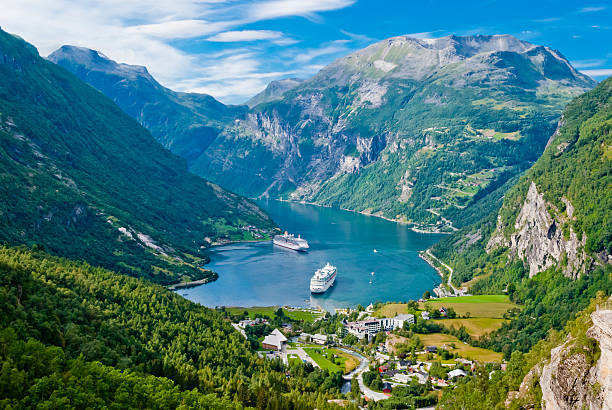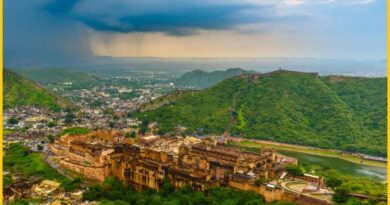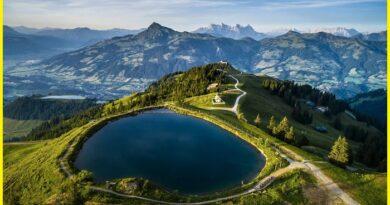10 Most famous Natural Attractions in Norway
Natural Attractions in Norway
Norway is a Nordic country in Northern Europe, the mainland territory comprises the western and northernmost portion of the Scandinavian Peninsula. Norway attracts thousands of tourists from all around the world with its varied landscapes that extend across the Arctic Circle. It is famous for its fjord-indented coastline and its mountains, ski resorts, lakes, and woods. Popular tourist destinations in Norway include Oslo, Ålesund, Bergen, and Stavanger. Much of the nature of Norway remains unspoiled, and thus attracts numerous hikers and skiers. The fjords, mountains, and waterfalls in Western and Northern Norway attract several hundred thousand tourists from all around the world each year. Here are the 10 best Natural Attractions in Norway.
The Seven Sisters Waterfall
The Seven Sisters is the 39th tallest waterfall in Norway. The 410-meter tall waterfall consists of seven separate streams, and the tallest of the 7has a free fall that measures 250 meters. The waterfall is located just south of the historic Knivsfla farm. The falls are about 6.5 kilometers west of the village of Geiranger and part of the Geiranger World Heritage Site. The waterfall is located along the Geirangerfjorden in Stranda Municipality in Møre og Romsdal county, Norway.

Fjord
The fjords of Norway are not-to-be-missed natural wonders. These Fjords formed during the ice ages by glacial erosion, the narrow clefts between high cliffs create tidal inlets. Here seawater meets along a coastline dotted with glacier valleys, natural harbors, steep rock, and lush greenery. The Geiranger Fjord is a fjord in the Sunnmøre region of Møre og Romsdal county, Norway. The fjord is a 15-kilometer -long branch off the Sunnylvsfjorden, which is a branch of the Storfjorden. The small village of Geiranger is located at the end of the fjord where the Geirangelva river empties into it.

Northern Lights
The natural wonder of the northern lights beautifies and brightens the night sky of Norway’s northern regions. It is Polar lights which are known as the aurora borealis, are a natural phenomenon found in both the northern and southern hemispheres that can be truly awesome and inspiring. Aurora borealis is also called the Northern lights. It is a dramatic, magical display that fascinates all human beings. It is the most famous natural attraction in Norway.
Also read- The Dominican Republic Tourist Attractions-Mountain, Beaches, Coffee, and many more
Midnight Sun
Midnight Sun is a natural phenomenon in Norway, occurring along the northern coast of Norway. From April to August head to the cities of Bodo, Lofoten, and Svalbard to take part in festivals and festivities celebrating 24 hours of sunlight. The phenomenon has at least made a lasting impression on several Norwegian artists and writers.

Svartisen Glacier
Svartisen means ‘black ice’, This frozen tongue of the glacier appears as a pretty powder blue. Formed over thousands of years, the ice in Svartisen is large without air bubbles, resulting in the color reflecting blue on the light spectrum. Engenbreen, part of Svartisen, is a popular hiking destination. An area with great hiking opportunities and the ultimate Norway destination.
Torghatten Mountain
Torghatten is a granite dome on the island of Torget. It is known for its characteristic hole, or natural tunnel, through its center. Torghatten Mountain is one of Norway’s most photographed places, it’s famous for the hole piercing its center where the sun shines through only twice a year. Geologists believe that it was created during the ice age as ice, water, and debris drilled their way through the rock. It is possible to walk up to the Torghatten on a well-prepared path, and through it on a natural path. It is one of the most famous natural attractions in Norway.

Kjeragbolten
Kjeragbolten is a natural wonder that will leave you wondering how did it happen? The location Kjeragbolten is a rock formation in which a large rock is stuck in a crack in the mountain. It has the appearance of a bolt, hence its name Kjeragbolten. Located on the Kjerag mountain, the 176-cubic-feet boulder hovers between a cleft on the mountainside and is also a favorite launch for base jumpers.
Saltstraumen Maelstrom
Saltstraumen is a small strait with one of the strongest tidal currents in the world. It is famous for its abundant birdlife and marine life. Here a 9.5-cubic-miles of seawater charges through a narrow channel only 2 miles long and 490 feet wide. Rushing at speeds of up to 20 knots, the tidal waters of Saltstraumen spin in vortices as it makes their way between the Saltfjord and the Skjerstadfjord every six hours.
Nigardsbreen Ice Cave
The deep blues Nigardsbreen Ice Cave, Formed from melting glacier ice. This cavernous 8-meter-high grotto is constantly shifting in hue, while huge icicles form above the 30-meter-deep lagoon. This is a spectacularly large, pristine ice cave beneath the Nigardsbreen region of Norway’s Jostedal Glacier National Park. Hiking along the outer glacier is popular with tourists, but due to the active melting ice, only supervised tours are permitted into the cave. It is one of the most famous natural attractions in Norway.

Spitsbergen island
The Spitsbergen island is the largest island within the Svalbard archipelago located 800 km north of mainland Norway in the middle of the Arctic Ocean. It is the only permanently inhabited part of the Svalbard archipelago. Spitsbergen island is famous for its fjord, rugged landscape, glaciers, mountains, and northern light. It is the most famous natural attraction in Norway.




Pingback: Las Vegas Nevada-A city of Entertainment, Casino and Amazing lifestyle - Geotourism